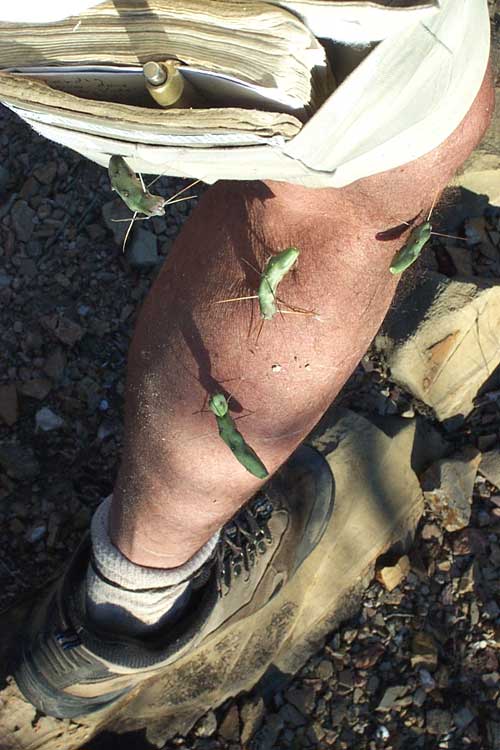Excerpts from Jim Conrad's
Naturalist Newsletter
from the February 23, 2007 Newsletter issued from Sierra Gorda Biosphere Reserve, QUERÉTARO, MÉXICO
ATTACKED BY A CHRISTMAS CACTUS
Wandering through the scrub, an odd sensation on the back of my right leg caught my attention. It was as if suddenly I'd developed some flab there and my walking was causing the flab to flop back and forth. I twisted around and looked down at the back of my leg and saw the heart-palpitating sight you can behold yourself below:

That picture shows four stem sections of a Christmas Cactus, CYLINDROPUNTIA LEPTOCAULIS, adhering to my body by their spines, one stuck to the shorts' pocket in which I carry my old birding field-guide, the other three very securely attached to the skin on the back of my leg. I can't account for my having been able to feel the cactus sections swinging back and forth, but not the spines stuck into my flesh. Well, you can see from my red, scratched and dirty legs that they'd been through a bit scrambling about the arroyos, so maybe they were just beyond feeling sharp sensations. However, when I extracted the spines -- and each section was attached by two or more well anchored ones -- I certainly felt that!
I backtracked and photographed what may have been my five-ft-tall, much branched donor cactus, and you can see that below:

I can hear some folks shaking their heads now saying that what's shown in that picture doesn't look anything like a Christmas Cactus, thinking that a Christmas Cactus is one of those benign little flat-stemmed cacti sold in pots, and which produce pretty, red flowers around Christmas time. Well, several cacti go by the name of Christmas Cactus and this is one of them. But neither does the plant in my picture look very Christmasy. I've seen the species when it did, however -- when it was fruiting. The fruits are bright red, so on green stems they can look as Christmasy as anything. Sometimes English speakers also call this cactus by one of its Spanish names, Tasajillo..
This is a common cactus extending from our northern Mexican uplands into Arizona, New Mexico, Texas and even Oklahoma. At the base of its spines appear dense tufts of very fine, sharp glochids, which I've told you enough about, and I got plenty of those while unsticking myself from the joints on the back of my leg.